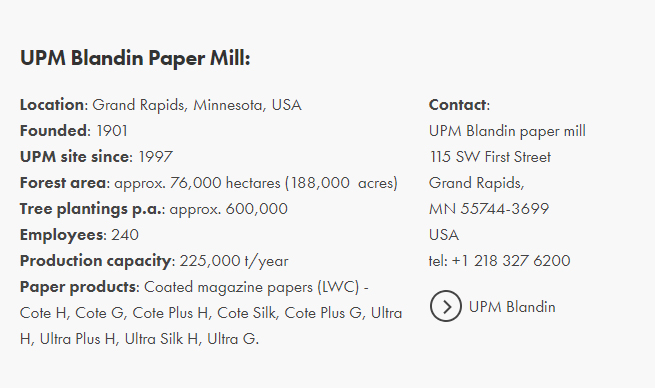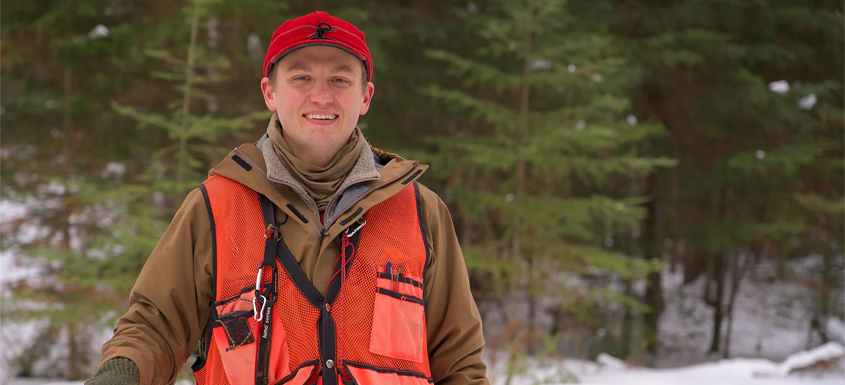On the Blandin forest lands in Grand Rapids, Minnesota, UPM foresters have found a smart way to make their woods future-proof through a consistent biodiversity concept, while safeguarding wood production. Forest ecologist Sawyer Scherer explains how.
Sawyer Scherer answers the most important question first: What exactly does Smart Forestry℠ mean? “Foresters used to look solely at trees and their productivity, we focus on the entire ecosystem and its long-term development. We understand that it helps everyone if we gear our forest management more specifically to nature and its needs - the climate, biodiversity, people, and the company. Following these guidelines, we have developed our own concept at UPM Blandin."
Scherer, 30, a forest ecologist who, together with four foresters and the Manager of Forest Resources, oversee UPM's forests in Minnesota – covering a total area of 1880 km2, about two and a half times the area of New York City. The team ensures that the forest remains productive – with the best possible plantings, the right harvest at the right moment, and optimal regeneration.
Forest management has a long tradition in the mid-western U.S. state. The Blandin paper mill in Grand Rapids, about 100 kilometers west of Lake Superior, was founded in 1901 and is one of the leading manufacturers of lightweight coated printing papers on the continent. Nature is also very important in Minnesota – the state boasts vast forests, thou
sands of lakes, and a diversity of ecosystems. This makes Minnesotans all the more concerned about the future as it relates to their forests. And this makes Smart Forestry℠ all the more important.
Monoculture forests are less resilient
There are many reasons for the shift to Smart Forestry℠, but the most important of them is resilience, and the watchword is biodiversity. "For decades, timber and pulp mill companies often planted a single tree species that met their needs. In this case, white spruce – fast growing, good for construction and paper products. Today, this single-crop approach is considered outdated. “We foresters are increasingly concerned with: How do trees respond to change," says Sawyer Scherer. "You see, the problem is: monoculture forests are inherently less resistant to insect infestations and diseases, floods and droughts, soil erosion, invasive species, and climate change."
We foresters are increasingly concerned with: How do trees respond to change
According to Sawyer this is where Smart Forestry℠ comes in. "White spruce is still the predominant tree species today. But we're planting it today in ecosystems where it occurs naturally." Among the approximately 600,000 trees planted annually by UPM Blandin, red pine, balsam fir, white pine and other species are increasingly being planted.
In concrete terms, Smart Forestry℠ means only planting trees that will thrive in an area – depending on the soil, wind, precipitation, vegetation and relief. This creates forests with many tree species, trees of different ages and sizes. "In the long term when the trees have reached maturity this strategy is also economically worthwhile. It limits the risk of loss significantly and protects the forest as a resource infinitely better," says Sawyer Scherer.
This approach is flanked by a life-cycle concept, which Scherer's team uses to study the development of trees from seedling onward and evaluate the effects of spacing regulations or regeneration harvests. In this way, valuable habitat criteria are integrated into forest planning. The conservation of deadwood as an area for lichens, mosses, fungi and animal species also plays a key role.
 While monocultural concepts (photo left) were predominant for a long time, diverse forestry (right) has become more important nowadays, due to climate change
While monocultural concepts (photo left) were predominant for a long time, diverse forestry (right) has become more important nowadays, due to climate change
Word of Smart Forestry℠ has long since raised interest and sparked discussion throughout the industry. Sawyer's team regularly exchanges ideas with scientists and forest managers across the region, as well as other UPM sites and shares their experiences in forums such as the Forest Responsibility Network. The UPM Blandin team's aspiration serves as a blueprint for as many as possible on how to future-proof our forests.
A long-term strategy rules
What can others learn from Smart Forestry℠? "The most important thing is to have a long-term business strategy," sums up Sawyer Scherer. UPM pursues a policy strategy that ensures the land remains intact, is maintained as a working forest and not developed. This allows UPM forest managers to take a long-term view of management, precisely because the forest cannot be used in any other way. "And last but not least, Smart Forestry℠ is also an important tool in mitigating climate change – by maintaining intact forests that remove CO2 from the air and thus play a crucial role in sequestering carbon emissions."

Source: UPM














